Herbs can make or break a dish. You can add the dry ones to food to make it taste better, but nothing beats the taste of freshly picked leaves.
In the winter, does that mean we have to settle for eggs with dried chives and cucumber basil salad without the basil?
No way! If you have a greenhouse or are thinking about building one, use it to grow herbs all year long.
We link to vendors to help you find relevant products. If you buy from one of our links, we may earn a commission.
You should have no trouble if you pick one that’s already been made or have access to one. There are just a few things to know, and to that end, here’s what we’ll cover coming up:
When this guide talks about a “greenhouse,” we mean both high tunnels and the traditional shed-like structure covered in clear glass or plastic.
The main difference is that high tunnels are tall enough to drive machinery into and they’re more portable.
High tunnels may provide slightly less protection than a true greenhouse. Otherwise, these are interchangeable for our purposes.
Low tunnels, hoop houses, and frost cloth are different beasts altogether, and those aren’t covered here.
Shelves can be used in the spring and summer to grow herbs, but these tips are mostly for growing in the fall and winter, when many of us need our greenhouses the most.
There’s nothing quite like the taste of freshly picked herbs to elevate your home cooking. But once winter hits, your herb garden likely goes dormant, leaving your kitchen bereft of that just-picked flavor. A greenhouse allows you to grow herbs abundantly all year long so you can snip fresh oregano, thyme, parsley and more anytime you want.
In this comprehensive guide you’ll learn everything you need to know about growing a thriving greenhouse herb garden that keeps you stocked with fresh flavor 12 months a year. From picking the right plants to proper care and maintenance, you’ll gain the skills to become a greenhouse herb-growing pro!
Benefits of Growing Herbs in a Greenhouse
Growing culinary herbs in a greenhouse offers many advantages over outdoor gardens:
-
Longer harvests – Sheltered conditions let you grow herbs for most of the year. Enjoy freshflavor even in winter.
-
Better growth – You can control factors like temperature, light, humidity and airflow to optimize growing conditions. Herbs may thrive better than outdoors.
-
Pest protection – Removing plants from the garden ecosystem prevents most pest and disease issues. No more chewed up basil leaves.
-
Easier care – Containing herbs in pots allows for tailored watering, fertilization and ample room for roots. Healthy plants result.
With a greenhouse, it’s simple to have an abundant supply of flavorful herbs no matter the weather outside.
Best Herbs for Greenhouse Growing
When selecting herbs for the greenhouse, choose varieties that tolerate cooler conditions well and don’t require a hot summer to thrive Great options include
-
Basil – Grows very well in greenhouses. Try compact types like ‘Spicy Globe’.
-
Chives – Handy perennial comes back every year. Garlic chives also do well.
-
Cilantro – Quick-growing and perfect for winter greenhouse conditions.
-
Dill – Appreciates the protected, humid environment of a greenhouse.
-
Marjoram – Flavors meats and vegetables with its sweet, woodsy flavor.
-
Mint – Invasive roots are contained, so mint thrives in a greenhouse.
-
Oregano – Rich, aromatic flavor perfect for pasta, pizza and more.
-
Parsley – Curly and flat-leaf parsley stay productive all winter long.
-
Rosemary – Evergreen herb grows slowly but beautifully in a greenhouse.
-
Thyme – Plant lemon thyme, English thyme and other culinary varieties.
Experiment with different types to learn which you use most in your cooking. You can continually add new herbs!
Setting Up Your Greenhouse Herb Garden
Growing abundant herbs in your greenhouse starts with providing optimal conditions. Follow these tips when establishing your setup:
-
Choose appropriate containers – Plant herbs in pots with drainage holes, using a quality potting mix. Clay, plastic or ceramic pots all work well. Match pot size to the herb’s mature size.
-
Allow room to grow – Herbs need adequate space for their roots and foliage. Allow 12-24 inches between pots depending on mature plant size.
-
Maximize light – Herbs grow best in full sun. Supplement natural light with grow lights if needed, especially in winter.
-
Promote air circulation – Good airflow prevents fungal diseases. Use small fans if needed to keep air moving.
-
Provide supports – Staking or caging tall herbs like dill prevents flopping over. Trellises work for vining herbs like creeping thyme.
-
Control pests – Isolating herbs in a greenhouse prevents most pests, but keep an eye out for aphids, whiteflies and fungus gnats. Remove affected plants promptly.
With the right foundations, your greenhouse herbs will thrive all year long!
Caring for Your Greenhouse Herb Garden
While herbs are generally easygoing, they do require some basic care to flourish in a greenhouse:
-
Water carefully – Most herbs prefer drier conditions. Allow the soil to dry out between waterings. Basil, mint and chervil like more moisture.
-
Use weak fertilizer – Herbs are light feeders but benefit from occasional fertilizer. Use half-strength liquid fertilizer every 2-3 weeks during the growing season.
-
Prune lightly – Prune herbs frequently to encourage bushy growth. Cut whole stems back to soil level. Avoid shearing.
-
Monitor for pests/disease – Humid conditions may encourage fungal issues. Improve airflow and promptly remove affected plants to prevent spreading.
-
Prepare for dormancy – Some herbs will go dormant over winter. Reduce water and stop fertilizing dormant herbs. Do not overharvest.
-
Transition seasons – Gradually introduce greenhouse herbs to outdoor conditions in spring over 1-2 weeks. Bring plants back inside at first signs of cold weather.
With attentive care, your greenhouse herb garden will stay lush and productive year-round!
Handy Solutions for Common Greenhouse Herb Problems
Even in ideal greenhouse conditions, herb gardens can sometimes run into issues. Here are some quick troubleshooting tips:
-
Leaf drop – If leaves turn yellow and drop, the plant is getting too much water. Allow soil to dry out between waterings.
-
Leggy growth – Insufficient light causes weak, leggy growth. Add grow lights or prune more frequently.
-
White mold – Powdery mildew fungus thrives in humidity. Improve airflow and remove affected plants promptly.
-
Slow growth – Herbs need repotting if roots fill containers. Use a slightly larger pot and fresh potting mix.
-
Wilting – Drooping leaves indicate under-watering. Check soil moisture and water plants when the top inch is dry.
-
Browning leaves – Over-watering causes root rot and leaf browning. Allow soil to dry out completely between waterings.
With attentive growing conditions and prompt troubleshooting, you can avoid most issues and grow thriving greenhouse herbs year after year.
Enjoying Your Bountiful Greenhouse Herb Garden
One of the best rewards of gardening is using the fresh ingredients you’ve grown yourself. Here are some great ways to put your greenhouse herb bounty to work:
-
Mix up custom dried herb blends for fall and winter cooking. Air dry extra herbs from your greenhouse harvests.
-
Whip up flavorful herb-infused vinegar, oils and butters. Great for making salad dressings, marinades and more.
-
Craft refreshing herb-filled waters and teas. Muddle herbs in water or steep in hot water for soothing herbal teas.
-
Create homemade gifts like herb sachets, herb-infused honey, bath and beauty products. Package in pretty jars or bags.
-
Freeze extra herbs in ice cube trays to toss into soups, stews and sauces all winter long.
When you can simply step into your greenhouse and snip fresh dill for your next batch of pickles or pluck perfect parsley to toss in a tabouli salad, you’ll never settle for flavorless dried herbs again!
Growing a year-round supply of greenhouse herbs takes your cooking to new heights. Follow these tips and soon you’ll be enjoying fresh herbal flavor no matter the weather outside!
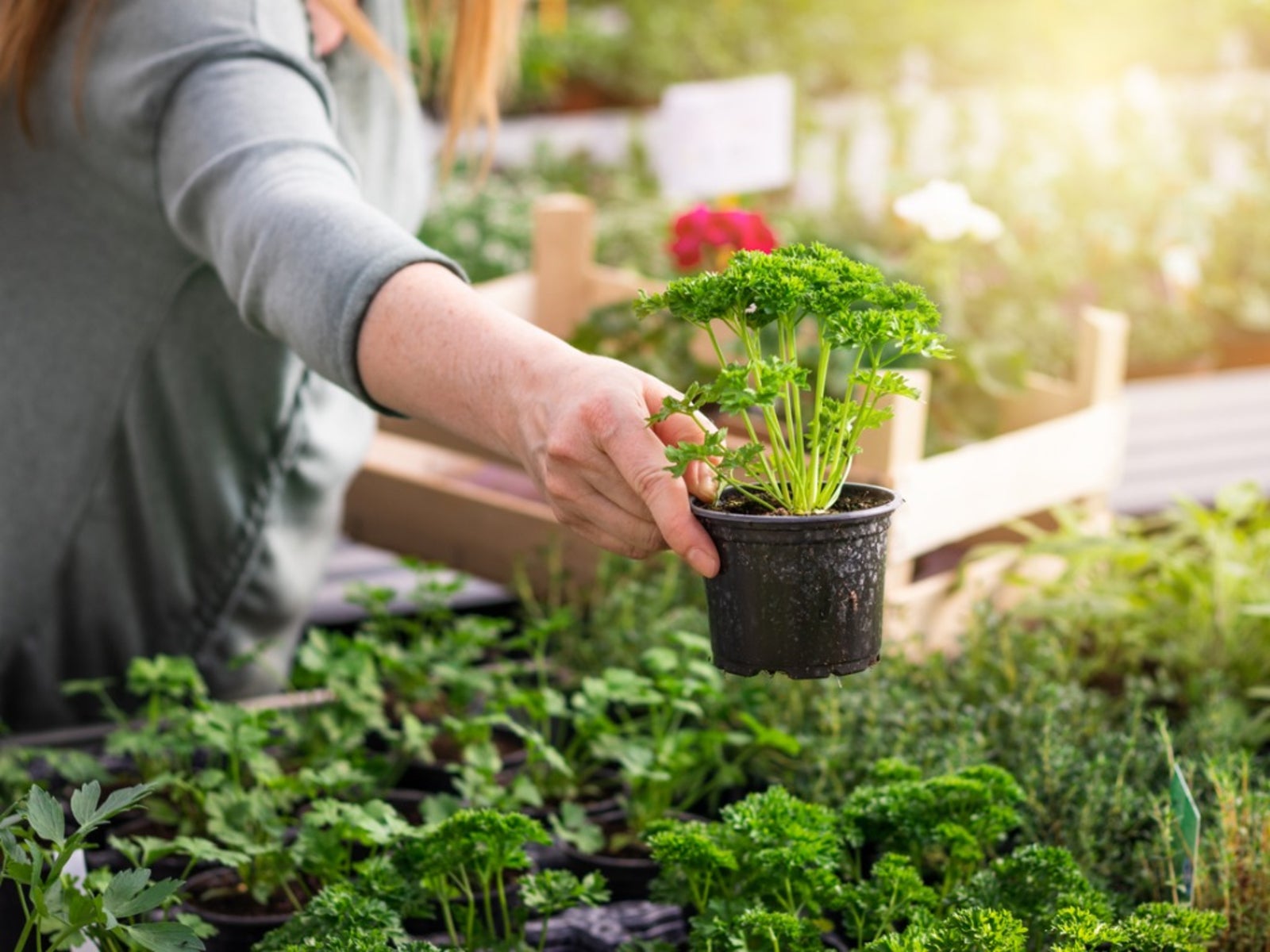
Why Use a Greenhouse to Grow Herbs?
Greenhouses provide gardeners with better control over the growing environment.
Where I live, the growing season depends entirely on how much rain we receive.
Even if the weather is right for planting, we might only have a few good weeks of growing one spring. On the other hand, if it starts to rain consistently in March, it might be perfect for planting that year.
Gardeners in other areas struggle with semi-regular late freezes or super early snow.
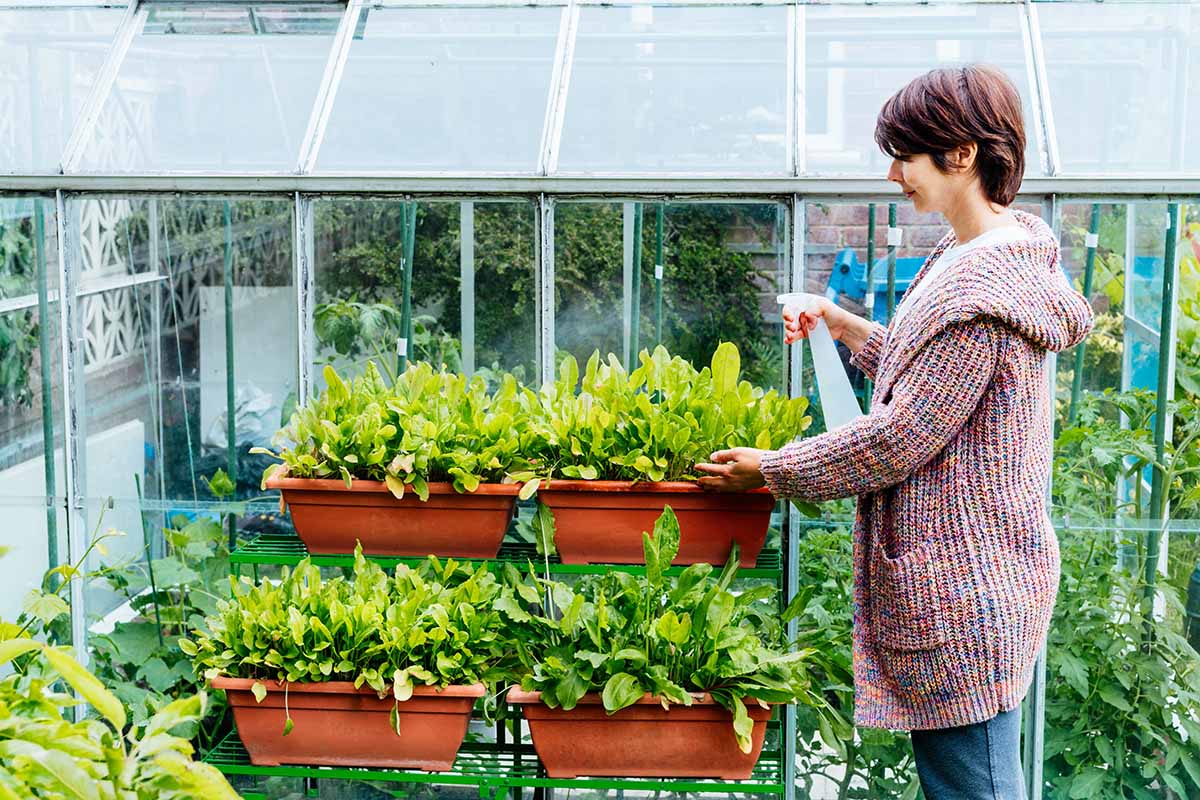
If you grow in a structure, on the other hand, you can protect your plants from rain, snow, and sudden freezes. If you add grow lights, you can control the amount of exposure your plants receive. Shades can protect plants from the heat of late summer.
A greenhouse can increase the ambient temperature compared to the conditions outside by 10°F or more.
Even without adding more heat, a double-layer tunnel or insulated, double-pane greenhouse can be up to 25°F warmer than the outside! This not only lets you extend the growing season by a lot, but it also lets people who live in places with cool summers grow plants that do well in the heat, like peppers and tomatoes.
Most herbs can be picked all year if you keep them in a greenhouse. They will stay green all winter.
You could eat a salad with fresh fennel and parsley even in the coldest, darkest part of winter. Or newly-plucked sprigs of rosemary and big bay leaves to enjoy at your holiday feast.
There are a few drawbacks that are worth balancing against the positives.
For example, a lot of the materials that are used in greenhouses and high tunnels block UVB light from reaching plants. This can make plants make less of some compounds that we want them to have more of, like antioxidants or compounds that make food taste better.
If you’re just constructing your greenhouse, choose a UV-Open product, if possible.
For instance, Be Cool Solutions IRAC MAX greenhouse film is made to prevent condensation while allowing UV rays to penetrate to the plants. Grab a 25-foot roll at Amazon.
Greenhouses also tend to be humid and that can lead to some fungal issues. Just keep an eye out for signs of disease, like leaves turning yellow and fungal spores on the stems or leaves of your herbs. It’s not the end of the world.
Species That Work Best
Many herbs are really great because they are easy to care for and can grow in your home, garden, or greenhouse. While just about any herb can do well in a greenhouse, some species do better than others.
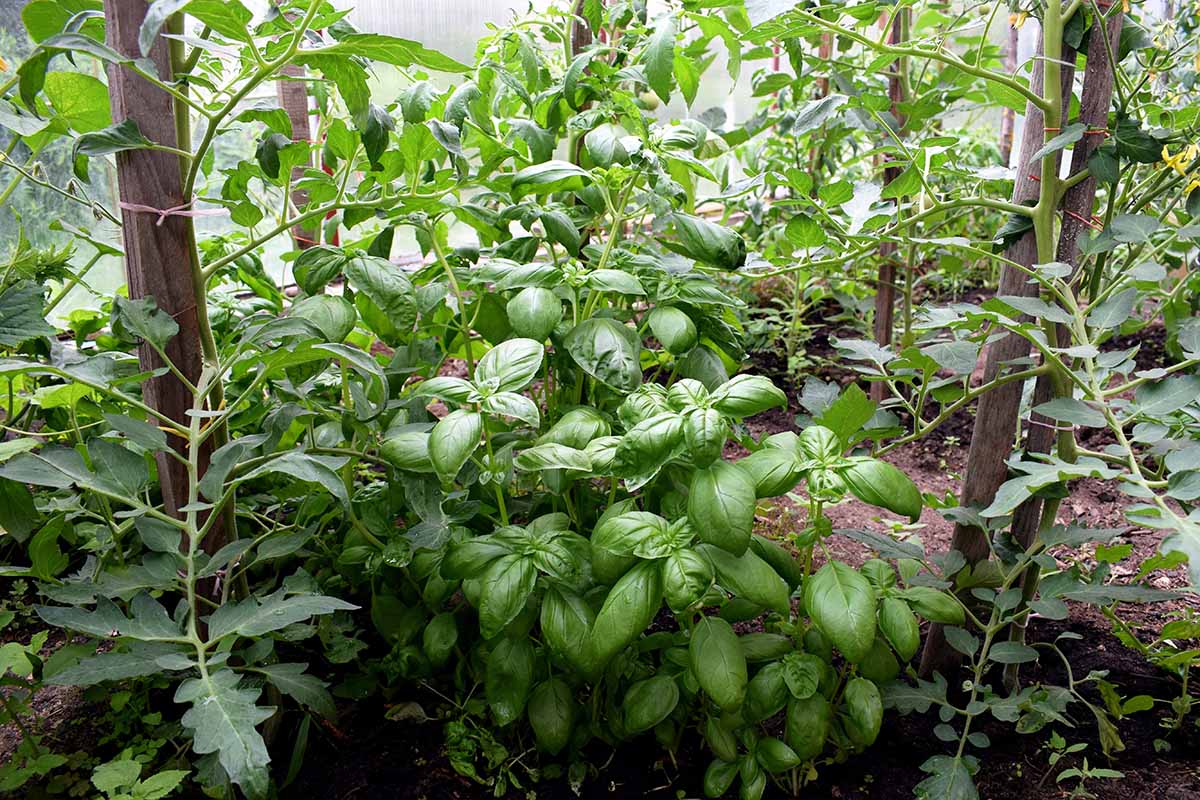
Ideal summer options include:
These plants will do better in a greenhouse because it will keep them warm in the winter and give them extra heat if you live somewhere that doesn’t get hot in the summer, like the Upper Midwest or the Pacific Northwest.
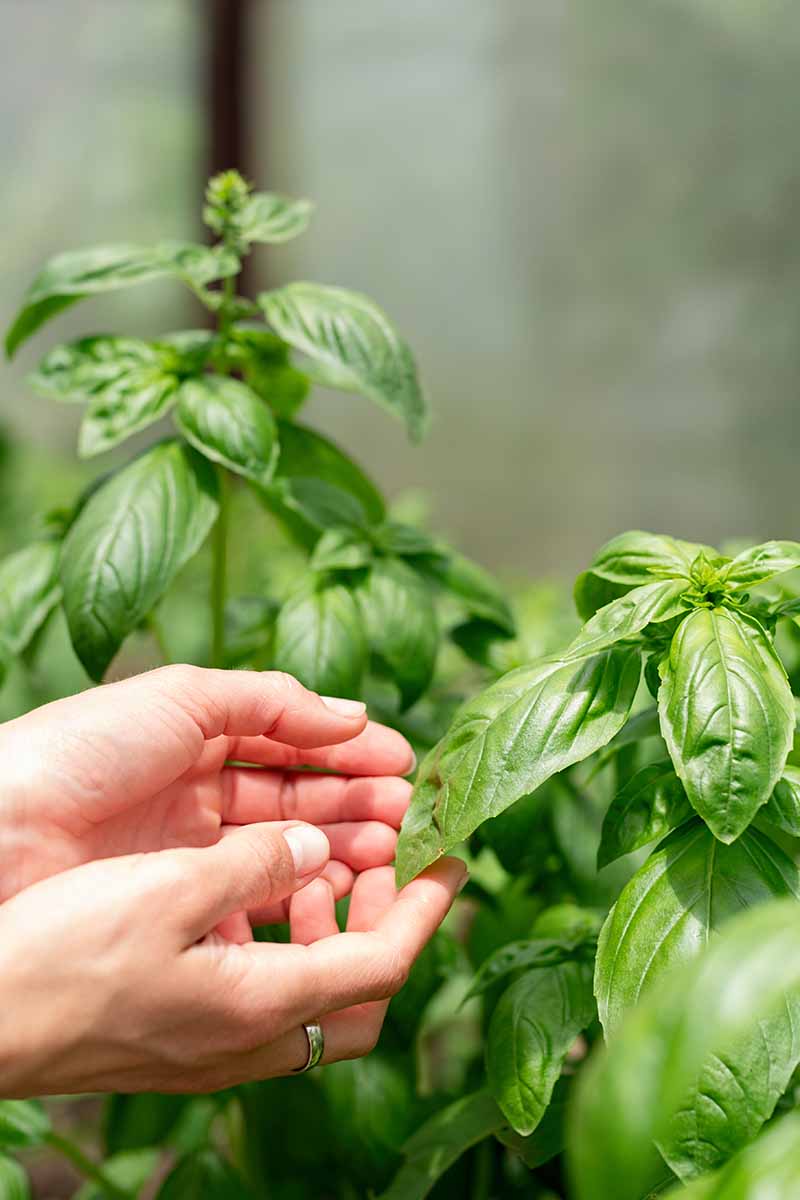
Excellent winter options include:
If you live in a place where it gets cold enough, you can grow any herb on this list in a greenhouse almost all year. But don’t feel limited to this list.
Some of my favorites include:
- Borage (Borago officinalis)
- Lovage (Levisticum officinale)
- Epazote (Dysphania ambrosioides)
- Ngo gai (Eryngium foetidum)
- Savory (Satureja montana)
- Shiso (Perilla frutescens var. crispa)
- Sweet cicely (Myrrhis odorata)
- Wasabi (Wasabia japonica)
You’ll need to pot up your herbs when you move them inside for the winter if they aren’t already growing in containers. You should dig as deep as the plant is tall, plus a few inches beyond the plant’s drip line.
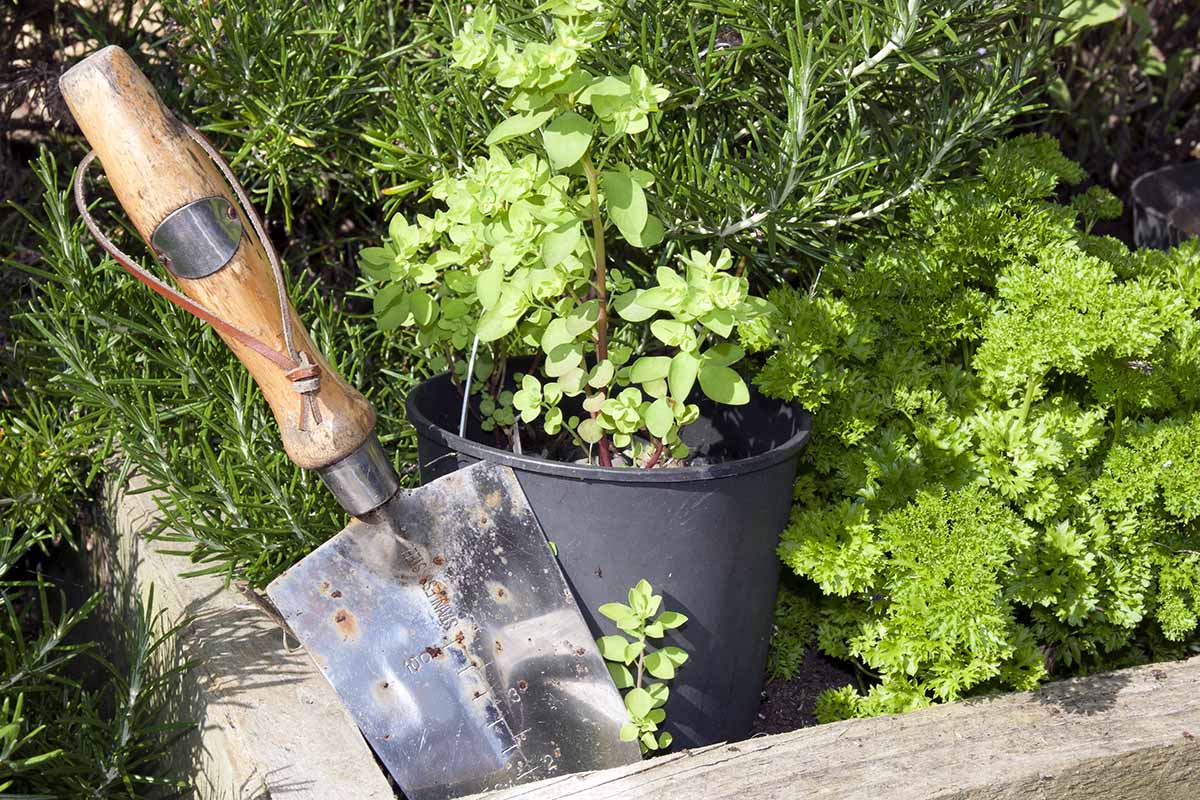
Put it in a pot that drains well and is the same size or a little bigger than the root ball. Fill in any gaps with potting soil.
Your plant will likely stay green all year in a greenhouse or high tunnel, but it will still go through a period when it doesn’t grow. Some species might die back entirely in the winter, while others slow down or stop growing.
You can still pick from plants that aren’t growing, but don’t take more than a quarter of the best growth above ground in the winter.
Because the plant is less active than it was during the summer, it needs less food and water. Or in many cases, make that no food and less water.
As a general rule, you should never feed your herbs during the winter months. As a general rule, you shouldn’t feed an herb that would normally die back or die off outside of a greenhouse in your area.

You also want to provide less water. In the winter, don’t water plants that like the soil to stay moist until the top half-inch or so is completely dry. Plants that like drier soil should be allowed to dry out even more.
During the winter, plants that don’t go to sleep will need less water because they aren’t getting as much sun and heat, so less water is evaporating.
You should also be extra, extra careful not to get any water on the leaves of your plants. You’re just asking for fungal issues if you do.
If you’re growing something delicate like basil or cilantro and a deep, long freeze comes through and you don’t have any extra heating to keep the building warm, you’ll need to give your plant some extra protection.
This can include covering pots with frost cloths or wrapping the base in burlap. For more tips on keeping plants happy in an unheated greenhouse, check out our guide.

Most herbs do fine with natural light, but in the winter, they probably won’t grow much or any new leaves just from natural light. If you want to encourage new growth or start seeds, you should consider using supplemental lighting.
One simple way to do this is with a grow bulb in a clamp reflector. For more serious growers, this can be a more complex system.
Unless a plant is obviously dead because of a disease or pest issue, don’t toss it out. Winter is a bad time for some herbs, even ones that stay green all year. This is true even if they are kept in a greenhouse.
I was shifting plants around once and left one of my favorite thymes outside. It got really, really cold for several days before I realized what I’d done.
By the time I rescued it, the leaves had fallen off and several branches seemed really unhappy. They were dry and crisp.
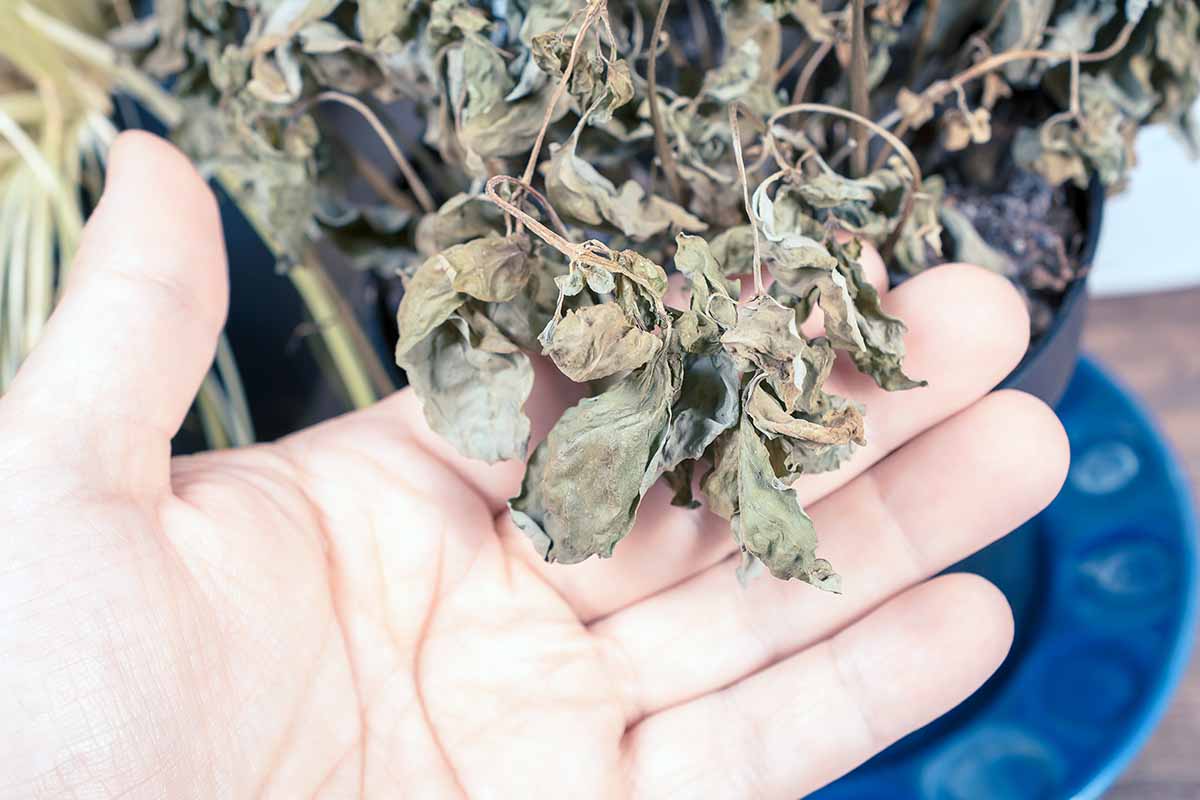
I cut the whole thing back to the soil level and put it back in the greenhouse. I watered it regularly (but sparingly) along with my other plants and crossed my fingers. Lo and behold, it returned better than ever with new shoots in the spring.
Even if your plants look dead in the middle of winter, don’t give up on them.
Some herbs are biennials and they will die after producing flowers and seeds in their second year. You can safely throw these away after collecting seeds to plant again if you want to, or when the last harvest is done after a successful first season.
You made it through another winter. Wow! Those plants must be dying! You want to take them out of the greenhouse and put them back in the garden right away.
Just one thing, first: They need to be hardened off. Generally, herbs should stay in the greenhouse until after the last predicted frost date for the year.
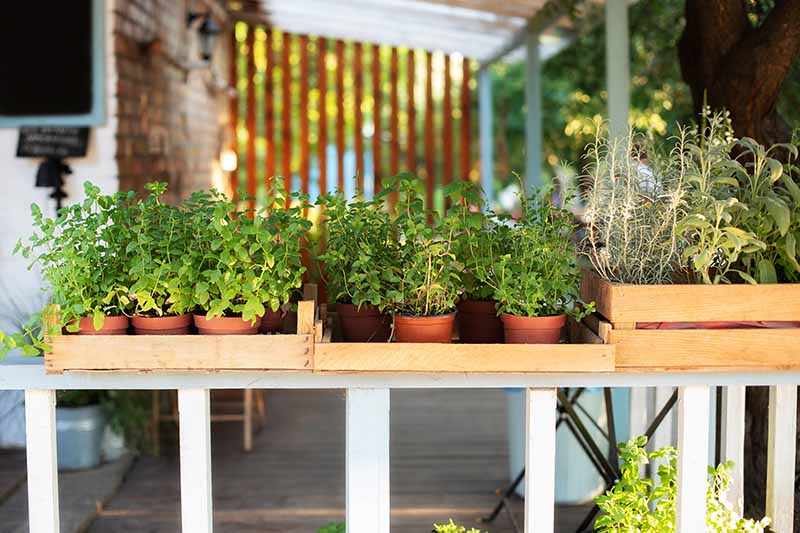
Once there is no longer a chance of frost, move each plant outside into a sunny, protected spot or let all the doors and vents open for an hour. On the next day, do this for two hours. Add an hour each day until the plant can handle eight hours of exposure.
Keep an eye on the weather report and move the plants back to the shelter until the frost melts and the weather gets warmer.
If there is an unexpected cold snap, you can start hardening off again when the weather is no longer frosty.
Once they are hardened off, you can move your pots to where they will stay or transplant herbs back to where they will stay.
Gardening Lessons : How to Grow Herbs in a Greenhouse
FAQ
How often do you water herbs in a greenhouse?
Does basil grow well in a greenhouse?
Do herbs like sun or shade?
Can you grow herbs in a greenhouse?
The answer to your problem is a greenhouse. Greenhouses provide an artificial environment that’s perfect for growing tender plants, and using a greenhouse for growing herbs can extend your season and increase the variety of plants you grow. Learn how to grow greenhouse herbs and some of the best varieties that thrive in a greenhouse environment.
What herbs grow in a greenhouse?
There are hundreds of different herbs that thrive in greenhouses. From classic meal staples like rosemary and basil to medicinal herbs like chamomile and ginseng, you can have a lush herb greenhouse garden.
How to propagate herbs and medicinal plants in a greenhouse?
There are different methods of propagating herbs and medicinal plants in a greenhouse, such as: • Seeds: This is the most common and natural way of propagating herbs and medicinal plants. It involves planting the seeds of the plants in the soil or containers and waiting for them to germinate and grow into new plants.
Why should you grow herbs and medicinal plants in a greenhouse?
Harvesting and using herbs and medicinal plants from your greenhouse is one of the most rewarding parts of growing them. You can enjoy their fresh flavors, aromas, and benefits for your cooking, health, beauty, or other purposes.
Should you plant plants in a greenhouse?
Greenhouse herb gardening can protect tender annuals from the extreme summer heat while extending the season and allowing your plants to grow earlier and later in the season. The key to getting the most out of your greenhouse is in setting it up before you add a single plant.
Can herbalists grow herbs without a greenhouse?
Many herbalists without access to heated greenhouses try to grow an excess of herbs during the warmer months. Many of these powerful plants can be frozen, preserved dried, or placed in oils to extend the length of time they will last.
- The Ultimate Guide to Growing Strawberries in Raised Beds - August 8, 2025
- No-Dig Garden Beds: The Easiest Way to Grow a Beautiful Garden - August 6, 2025
- How to Protect and Preserve Wood for Raised Garden Beds - August 6, 2025
